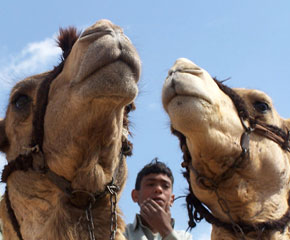Think again, says Nancy Abeiderrahmane, who runs a camel dairy in the Saharan state of Mauritania and says vitamin-rich camel milk can cleanse the body both inside and out.
“It does give you a nice complexion,” says British-born Abeiderrahmane, who in 1989 opened Africa’s first commercial camel milk dairy, now called Tiviski, in Mauritania’s capital Nouakchott.
With the dairy already producing a range of camel, cow and goat milk products in a nation where nomadic livestock rearing is a way of life, the Spanish-trained engineer is now looking at the possibility of making camel milk cosmetics.
“We would make creams and soaps,” said Abeiderrahmane, who has lived in Mauritania for 30 years and is a citizen of the former French colony lying on the Sahara’s western edge. “I’m thinking very upmarket,” she added.
Recalling that Egypt’s Queen Cleopatra, a fabled beauty, was said to bathe daily in camel’s milk, she said Mauritanian Moorish women still traditionally drank large quantities of this milk to maintain a pale, clear complexion.
While stressing that simply drinking camel milk was already an excellent beauty treatment, she said its fat could be transformed into lotions and creams.
A handful of entrepreneurs in the world already made such products, although Abeiderrahmane, an acknowledged expert on camel milk, said she would need to acquire the technical know-how to set up a cosmetics plant at her Nouakchott dairy.
“There is nobody in 600 miles who makes cosmetics,” she said, gesturing to the edge of the dusty Mauritanian capital, where rolling sand dunes begin where the buildings end.
Just a few miles away on a sandy roadside, Mauritanian herders, their craggy, weather-beaten faces swathed in turbans, milk a herd of baying, moaning camels.
They feed the females a hash of cereals and peanuts mixed with water before milking. It takes two people to milk a standing camel, one holding the bowl on one side and the other tweaking the teats of the udder on the other side
The milker allows the female camel’s calf to start suckling, to draw down the milk, and then pushes it away.
Dry camel droppings scatter the sand underfoot and there is a rank, acrid smell of camel urine in the air. Abeiderrahmane, while admitting camels can be smelly, indignantly denies they are dirty.
Fresh from the udder, camel milk is topped by a thick white froth. It tastes different to cow milk, less fatty and sometimes a bit saltier, and its chemical composition is very different.

